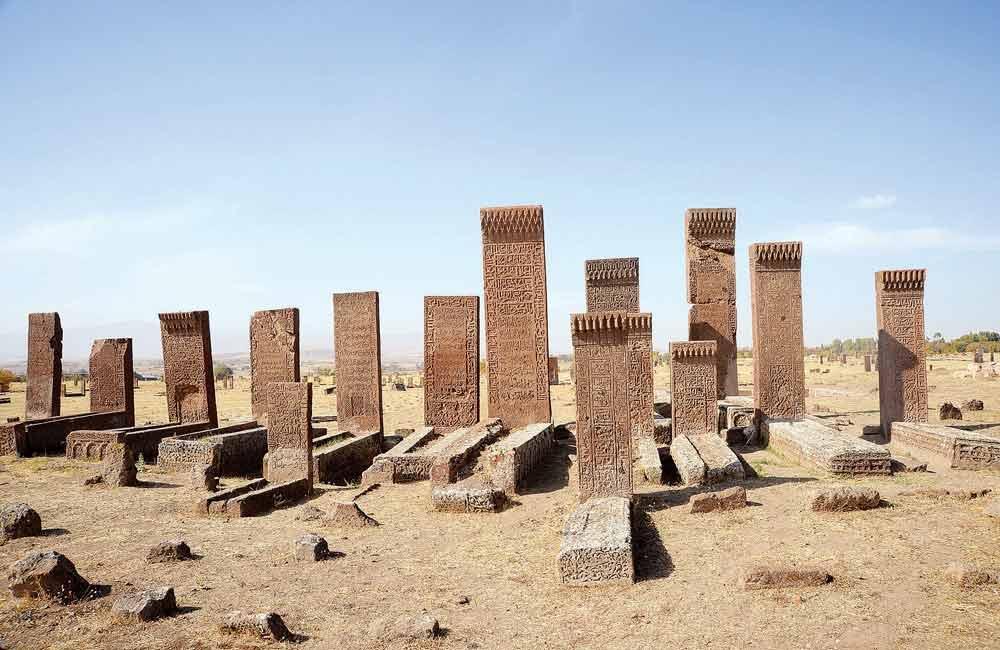Seljuk Cemetery seeks spot in UNESCO list
BİTLİS - Anadolu Agency

A group of giant Seljuk tombstones in Turkey’s southeastern province of Bitlis could join the permanent UNESCO World Heritage List in 2019. The 400- to 700-year-old gravestones are currently on the temporary list.
The cemetery, which is the largest in the Islamic world, is located in the Ahlat district of Bitlis, an area also known as “Kubbetul-Islam.”
Describing the tombs as “monuments,” provincial director of the Culture and Tourism Ministry Ramazan Gencan said the Seljuk Cemetery was of vital importance to the Turkish-Islamic world, second only to the proto-Turkic Orhon inscriptions in Mongolia.
The Seljuk Square Necropolis, built on a 220-square-meter area, includes more than 8,000 tombs, with various reliefs and carvings, including ornamental, cairn and cist-type
sepulchers.
Gencan also spoke about ongoing excavations at the site as local, national and international teams work together under the auspices of the Turkish government.
“Our excavations are continuing. We are unearthing tombs, making repairs and restoration works and cleaning stones,” he added.
Recai Karahan, head of the excavations, said his team had repaired nearly 600 tombstones over the last seven years. Some 550 tombstones have been transcribed while another 500 have been cleared of lichens, he added.
‘Nothing else like it’
Karahan, a professor of art history at Yüzüncü Yıl University in the eastern province of Van, stressed the cemetery’s uniqueness.
“There is no other cemetery of its kind. Giant 4-meter-high monolithic tombstones, with an additional one to one-and-a-half meters underground, are unique features of the Seljuk necropolis,” he said.
Karahan also stressed Ottoman-era ornamentations, with geometrical and floral decorations, calling the tombs “cultural works.”
Bitlis Governor Ismail Ustaoğlu said the excavations could boost tourism in the region, praising their engravings, motifs and unrivalled height.
“Verses from the Quran and hadiths, as well as some brief information about the people buried, are all written on the tombstones,” he said.
UNESCO’s website also lauds the site, saying Ahlat features “some of the most outstanding tombstones and mausoleums of the early Turkish period in Anatolia.”
“These works are not only important sources of information on the technical and decorative repertoire of the period, but also act as historical sources for important masons and craftsmen, whose names appear in inscriptions there,” it adds.
UNESCO’s 39th General Conference is being held in Paris from Oct. 30 to Nov. 14.
Turkey’s first entries in UNESCO’s World Heritage list were in 1985, with the Goreme National Park and rock landscapes of Cappadocia, the Great Mosque and Hospital of Divriği in central Turkey and the historic areas of Istanbul.
The Hittite capital Hattusha was added in 1986, followed by Mt. Nemrut in 1987, and Hierapolis-Pamukkale and the ancient city of Xanthos-Letoon in 1988.
In 1994, the city of Safranbolu also entered the list, followed by the archaeological site of Troy in 1998, Selimiye Mosque and its social complex in 2011, and the Neolithic site of Çatalhöyük in 2012.
The latest entry came in July, with the inclusion of the Aphrodisias archaeological site in southwestern Turkey.
















